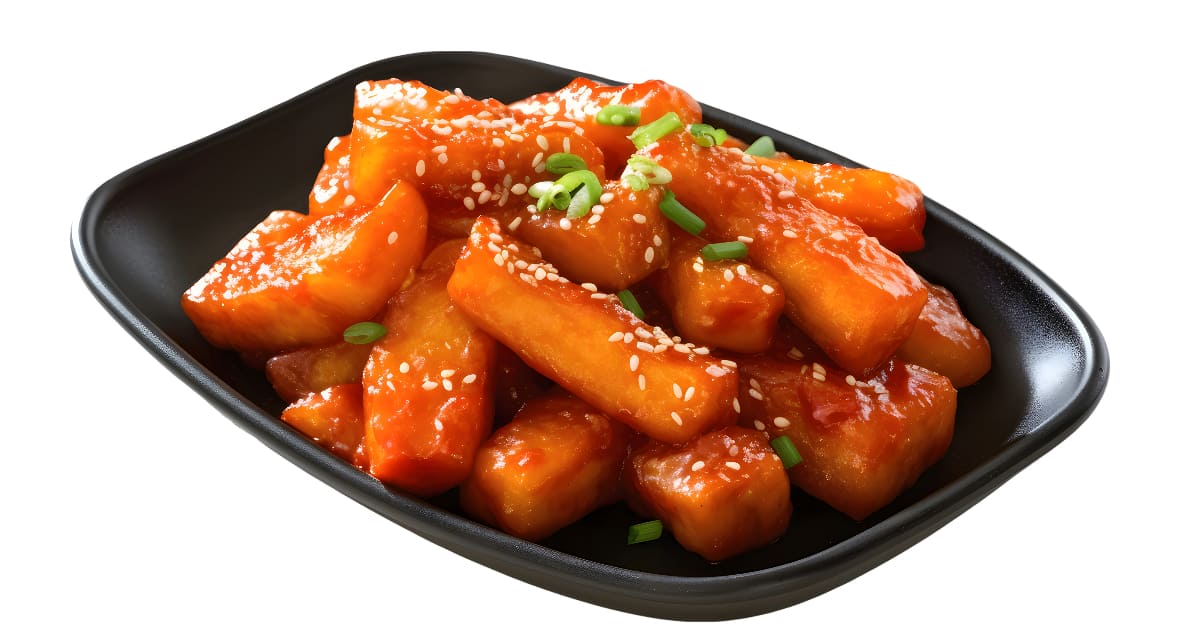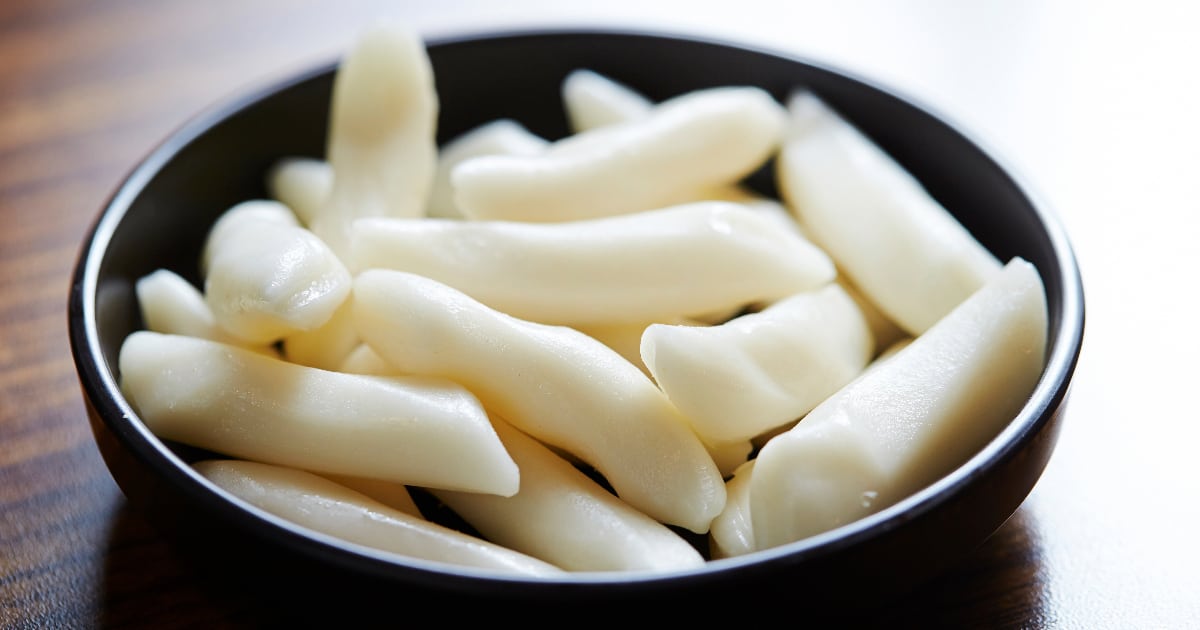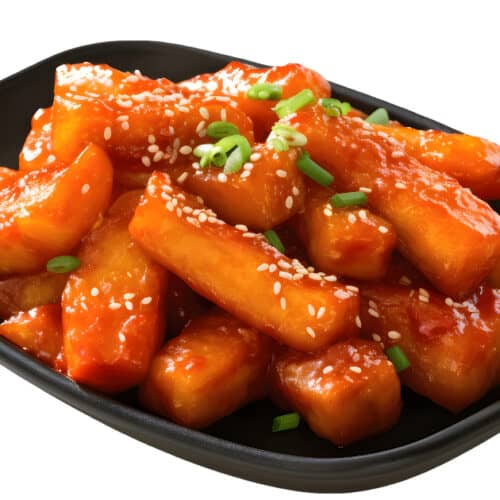Gochujang, the Korean fermented red chili paste, adds a delicious kick of spice, umami, and sweetness to many classic Korean dishes.

One such dish that is practically synonymous with gochujang is the iconic tteokbokki, chewy rice cakes simmered in a spicy-sweet gochujang-based sauce.
This easy yet flavor-packed gochujang tteokbokki recipe allows you to recreate this popular Korean street food snack in your own kitchen.
Tteokbokki and Gochujang
Tteokbokki directly translates to “stir-fried rice cakes” in Korean. However, the cooking method primarily involves simmering cylindrical-shaped rice cakes in a sauce as opposed to stir-frying. The finger-sized soft and chewy rice cakes act as the perfect vehicle for absorbing the complex flavors of the spicy, sweet, and umami-rich sauce.
While there are many variations of tteokbokki, the signature sauce is based on Korea’s most iconic condiment: gochujang chili paste. This thick, pungent fermented chili paste forms the base for countless Korean dishes beyond just tteokbokki.
Gochujang not only provides spicy heat but also contributes sweet, salty, and umami elements. It undergoes a lengthy fermentation process using chili powder, glutinous rice, fermented soybeans, and salt that yields a rich, nuanced flavor profile. When combined with other classic Korean pantry ingredients like sesame oil and soy sauce, gochujang makes for an addictively complex tteokbokki sauce.
Choosing the Right Rice Cakes

The ideal type of rice cakes for tteokbokki are short, tubular, finger-sized cakes made from just rice flour and water. Opting for rice cakes crafted solely from rice flour as opposed to wheat ensures the distinctive chewy and bouncy texture. The short cylindrical shape allows the cakes to soak up the maximum amount of sauce.
Longer, flatter rice cakes may also be used but they do not absorb as much flavor. Very thick, dense rice cakes do not work well either, as they require longer cooking times and may not soften sufficiently.
When shopping, look for rice cakes made only with rice flour and water, free of added wheat. Pick freshly made refrigerated rice cakes from Asian grocery stores for best results, as opposed to frozen kinds.
Must-Have Korean Pantry Staples for Gochujang Tteokbokki
Beyond the two-star ingredients of rice cakes and gochujang, a handful of other Korean pantry essentials help build out maximum flavor in the tteokbokki sauce:
- Gochugaru (Korean red chili flakes) - Contributes a vibrant red hue and another layer of spicy heat. Use the fine powder for smooth, even distribution.
- Sesame oil - Adds nutty, aromatic sesame flavor. Use toasted for a bolder impact.
- Soy sauce - Provides salty, savory umami notes. Use regular or low-sodium.
- Brown sugar or honey - Adds subtle sweetness to balance the heat.
- Garlic - Korean cuisine loves garlic. It enhances the pungency and aroma.
- Ginger - Fresh ginger heightens the brightness and cuts through the rich sauce.
- Korean corn syrup - Imparts a glossy sheen, texture, and subtle sweetness.
- Anchovy stock - Made by simmering dried anchovies, it provides a huge umami punch.
This classic combination of ingredients yields a complex sauce that brilliantly coats and seeps into the chewy rice cakes.
Ratios for Balancing Tteokbokki Sauce
Getting the ratios of the primary flavor components right is key to making irresistible gochujang tteokbokki:
- Gochujang - 1-2 tablespoons. Start smaller if spice-sensitive.
- Gochugaru - 1-2 teaspoons. Omit if using very spicy gochujang.
- Soy sauce - 1-2 teaspoons.
- Brown sugar - 1-2 tablespoons.
- Garlic - 1 teaspoon minced.
- Ginger - 1 teaspoon minced.
- Sesame oil - 1 teaspoon.
- Corn syrup - 1-2 tablespoons.
- Anchovy stock - 1-2 cups.
Adjust to your personal taste preferences. Like it sweeter? Add a touch more sugar. Want extra kick? Use an extra spoonful of gochugaru. Play around to find your ideal balance.
Step-By-Step Gochujang Tteokbokki Recipe
Now that the key ingredients are covered, here is a simple walkthrough for putting together authentic gochujang tteokbokki at home:
1. Make the Anchovy Stock
Simmer dried anchovies and seaweed in water for 10 minutes then strain to yield the umami-rich stock.
2. Combine Sauce Ingredients
Whisk together the gochujang, gochugaru, soy sauce, brown sugar, garlic, ginger, sesame oil, and corn syrup.
3. Parboil the Rice Cakes
Parboil the rice cakes for 2-3 minutes until slightly softened. Drain and set aside.
4. Simmer the Sauce
Add the sauce to a skillet and simmer for 2-3 minutes until thickened slightly.
5. Toss in Rice Cakes
Add the parboiled rice cakes and coat thoroughly with sauce.
6. Cook Until Tender
Simmer for 5-7 minutes, gently tossing occasionally, until rice cakes are heated through and turn tender.
7. Finish with Garnishes
Top with sesame seeds and scallions for garnish and extra flavor. Enjoy the spicy, sweet tteokbokki immediately while hot!
Tips for Nailing Perfect Gochujang Tteokbokki
Here are some handy tips to help you achieve the ideal texture and flavor:
- Use an oven-safe skillet to allow simmering sauce and rice cakes together.
- Parboil the rice cakes briefly to allow better absorption of sauce.
- Toss the rice cakes in the sauce frequently for even coating.
- Simmer over medium-low heat to prevent scorching.
- Cook until rice cakes are heated through and turn soft and plump.
- Add extra anchovy stock to loosen the sauce if it gets too thick.
- Garnish with sesame seeds and scallions for texture and flavor.
- Serve immediately and enjoy hot for ideal spicy, sweet flavors.
Favorite Additions to Customize Your Tteokbokki
While the basic rice cakes and gochujang sauce combo is classic, you can also add your own spin with extra ingredients:
- Fish cakes - Traditional tube-shaped fish cakes contribute extra protein.
- Soft tofu - Silky cubes of tofu add richness.
- Ramen noodles - For extra carbs and texture.
- Vegetables - Onions, cabbage, and carrots lend crunch.
- Eggs - Boiled eggs or egg yolk make it a meal.
- Cheese - Ooey melted cheese pairs perfectly with spice.
Get creative with mix-ins to create your own personalized gochujang tteokbokki experience!
Enjoy Tteokbokki Hot for the Best Results
Since tender rice cakes have a tendency to stiffen as they cool, tteokbokki is definitely best consumed immediately after cooking while still piping hot. The hot temperature allows the rice cakes to remain soft and soaked with sauce. Any leftovers can be refrigerated and reheated the next day, but the texture will not be quite as pleasing.
For maximum enjoyment, try gathering friends or family together for a fresh batch straight out of the wok. Serve alongside an ice-cold Korean beer, and let the gochujang spice up your meal!
Recreate More Korean Favorites with Gochujang
Once you witness how brilliantly gochujang amplifies tteokbokki, explore using it to add that same addictive depth of flavor to other Korean recipes:
- Gochujang chicken - Brushed on grilled or baked chicken.
- Gochujang pork - Marinate pork belly slices in a gochujang mixture.
- Gochujang fried rice - Stir gochujang right into kimchi fried rice.
- Gochujang jeon - Mix gochujang into pancake batter.
- Gochujang dipping sauce - For dumplings, spring rolls, and more.
With its winning combination of sweet, salty, spicy, and umami, gochujang makes for the ultimate Korean flavor booster. Let it infuse its magic into your own kitchen creations!
FAQs
What are some substitutes if I don't have gochujang?
The complexity of gochujang is hard to replicate, but in a pinch, you can mix together chili garlic sauce, miso paste, sesame oil, rice wine vinegar, and a touch of sugar.
Can I use hot water instead of anchovy stock?
You can, but the anchovy stock adds a hugely important savory umami flavor. Opt for another veggie or seafood-based broth for the best flavor.
Is there a quick way to soften refrigerated rice cakes?
Soak refrigerated rice cakes in very hot or boiling water for 5 minutes prior to cooking to quickly soften them up.
What's the difference between the tubular and oval rice cakes?
The short tubular kinds are ideal for absorbing maximum sauce and flavor. Oval or flat kinds don't soak up as much sauce.
Can I prepare the dish in advance?
It's best to cook and serve tteokbokki immediately. The rice cakes stiffen as they cool. You can refrigerate leftovers but the texture suffers.
Conclusion
With this easy gochujang tteokbokki recipe, you can now bring the addictive flavors of this Korean street food favorite into your own kitchen. Let the complex sweet, spicy, salty, umami notes of the iconic gochujang sauce seep into the chewy rice cakes.
Adapt it to your tastes and add your own creative extra ingredients. Enjoy this fast weeknight dish hot off the stove for an authentic and satisfying Korean meal.

Gochujang Tteokbokki Recipe
Ingredients
- 1 lb tubular rice cakes
- 3 Tbsp gochujang (Korean chili paste)
- 1 Tbsp gochugaru (Korean chili flakes)
- 2 Tbsp brown sugar
- 1 Tbsp soy sauce
- 1 tsp sesame oil
- 1 tsp minced garlic
- 1 tsp minced ginger
- 1-2 cups anchovy stock
- Green onions, sliced
- Toasted sesame seeds
Instructions
- Make the anchovy stock by simmering dried anchovies and seaweed in water for 10 minutes. Strain and reserve the stock.
- In a bowl, combine the gochujang, gochugaru, brown sugar, soy sauce, sesame oil, garlic, and ginger.
- Parboil the rice cakes for 2-3 minutes to soften. Drain and set aside.
- Add the sauce mixture to a skillet and simmer for 2-3 minutes.
- Add the parboiled rice cakes and toss to coat evenly with sauce.
- Simmer for 5-7 minutes, tossing occasionally, until rice cakes are tender.
- Serve hot, garnished with green onions and sesame seeds.

